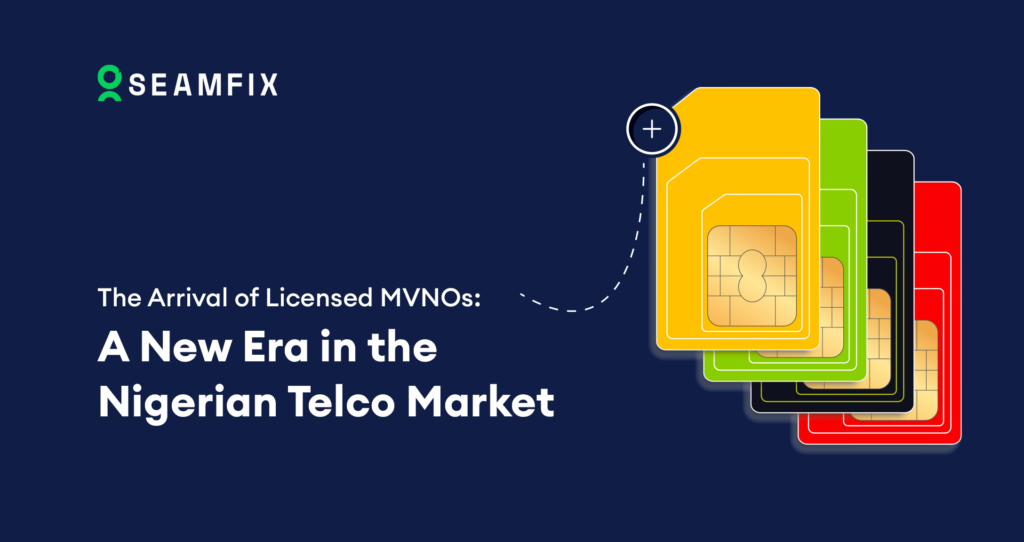The Arrival of Licensed MVNOs: A New Era in the Nigerian Telco Market
Introduction
In recent times, the Nigerian telecommunications market has witnessed a significant development with the entry of licensed Mobile Virtual Network Operators (MVNOs). These new players are set to revolutionize the industry by offering innovative services and introducing healthy competition. In this article, we will explore what MVNOs are, how they operate, their different category tiers, and the potential impact they may have on the Nigerian telco market.
Understanding MVNOs
MVNO stands for Mobile Virtual Network Operator. Unlike traditional mobile network operators (MNOs) that own and maintain their physical infrastructure, MVNOs do not possess their own network infrastructure. Instead, they rely on existing Mobile Network Operators (MNOs) to provide the necessary network services. Essentially, MVNOs purchase wholesale mobile services from MNOs at a negotiated rate and repackage them under their own brand name.
Operational Model of MVNOs
MVNOs operate by establishing partnerships or leasing agreements with MNOs, gaining access to their networks, and utilizing their existing infrastructure. This enables MVNOs to offer voice, data, and messaging services to their customers without having to invest in expensive network infrastructure. The MVNOs differentiate themselves from the MNOs by targeting specific customer segments, offering unique service plans, or providing value-added services.
Benefits and Opportunities
Increased Competition: The entry of licensed MVNOs introduces much-needed competition in the Nigerian telco market. This competition is likely to result in lower prices, improved service quality, and enhanced customer experience as MNOs strive to maintain their market share.
Targeted Niche Markets: MVNOs have the flexibility to target specific customer segments or niches that may be underserved by traditional MNOs. By tailoring their offerings to meet the needs of these segments, MVNOs can provide specialized services, customized plans, and enhanced customer support.
Innovation and Differentiation: MVNOs can bring a fresh wave of innovation to the telco market, introducing new business models, unique service offerings, and technological advancements. Their agile nature allows them to respond quickly to changing market dynamics and customer demands, fostering innovation and driving overall industry growth.
Partnership Opportunities: MNOs can benefit from partnering with MVNOs by leveraging their expertise in niche markets, enhancing their product portfolios, and generating additional revenue streams. These partnerships can help MNOs expand their market reach, increase customer loyalty, and optimize network utilization.
Regulatory Framework and Licensing
To operate as an MVNO in Nigeria, companies must obtain a license from the Nigerian Communications Commission (NCC). The NCC’s licensing framework ensures that MVNOs comply with regulatory guidelines, promotes fair competition, and protects consumer interests. The licensing process involves a thorough assessment of the applicant’s business plan, technical capabilities, financial stability, and compliance with relevant regulations.
MVNO Service Operations in Nigeria
The operations of an MVNO within the Nigerian market is represented as subsystems which indicates the level of control an entity possesses within the mobile service delivery value chain.
A 4-tier system was implored with an opportunity to choose a unified license in which the entity has the freedom to operate within any of the tiers.
Find a breakdown of the different tiers operations below:
Tier One: Services Virtual Operator
A Virtual Operator within this tier leverages on its ability to offer services to its customers without owning any switching or intelligent network infrastructure. They do not control any numbering resources.
Responsibilities lie with the host Licensee to provide wholesale capacity to the V.O for delivery of its products and services.
VAS services are the differentiating factors for VOs and rely on a revenue sharing model for calls as a simple reseller, or sufficiently limited tariff and pricing control as a more enhanced virtual service provider. Its pricing infrastructure is strongly tied to that of its host.
This license therefore subsumes the VAS providers’ license and applicable conditions within VAS license must be adhered to by a VO providing VAS. They can run their own SMSC, distribute and own their own content, as well as offer basic network services such as voicemail to their customers.
The Operator is free to operate in at least one of the following areas:
- Own Brand
- Own Sales and Distribution channels
III. Device and Phone sales and management
- Limited tariff control
- Customer Relation Platform
- Own Content/Applications
VII. Host and distribute VAS
VIII. Can run SMSC for SM
Tier Two: Simple Facilities Virtual Operator
A Virtual Operator within this tier assumes more control of the value chain which allows it to significantly differentiate itself from its host. The VO does not have Core Switching and Interconnect capabilities but can set up its own Intelligent network (IN) to provide their own IN services to the customer.
It can own more of the customer segment than Tier-1 operators with the capacity of establishing its own Home Subscriber Register or Authentication centre, Equipment Identity Register, and Home Location Register, if it desires to.
They rely on the number ranges of their host MNOs although they have access to short codes or premium numbers for customer care and must adhere to the guidelines set forth by the Commission.
Its capacity to control its own tariff structure and packages to a high degree allows it to generate its own revenue through traffic from its own customers but relies on a shared revenue structure with the host for inbound calls.
The VO can manage areas from Tier – 1 in addition to at least one of the following areas:
- Owns and issues its SIM
- Owns and operate its own Intelligent network
III. Own and Operate EIR/HLR/AUC/HSS
Tier Three: Core Facilities Virtual Operator
Within this tier, an operator relies on its technical and commercial prowess to launch and operate a full core network with switching and interconnect capabilities.
The VO relies totally on its host to provide Radio Access capacity at wholesale to deliver its products and services to its customers.
The VO can engage in interconnect agreements with other network providers. Revenue generation stems from both outbound and inbound calls which gives it full control over its tariff structure.
VOs within this tier are earnestly urged to target underserved and unserved areas with subsidised requirements to operate in those areas, being taken under consideration by the Commission.
The VO can manage areas from Tier – 2 in addition to at least one of the following areas: I. Owns and manages core network elements (switching and interconnections including:
- IP Multimedia Subsystem
- MSC and GMSC
- PGSN/PGW
- SGSN/SGW
- MME
Tier Four: Virtual Aggregator/Enabler
The operator within this tier is responsible for aggregating and/or Enabling VO services within the market. It relies on a model in which it stands as a middleman between the MNO and multiple VOs
The aggregator is responsible for purchasing bulk capacity from a licensed network operator, and reselling it to multiple VOs, therefore streamlining the process of negotiating capacity agreements with said network operators.
The aggregator is permitted to choose what level of the value chain it desires to aggregate. This means that an aggregator can rely on its host for switching and interconnect purposes but control its intelligent networks and content delivery platforms, therefore only capable of aggregating VOs from tier – 2. It is usually not common to see aggregation of tier – 3 VOs, but it is technically possible.
Enablers on the other hand provide a platform which VOs can “outsource” the heavy lifting of B/OSS (Business/Operations Support Systems) processes to, while they focus on the sales, marketing, and distribution aspect of the value the VOs are creating.
In pursuant of the objective to improve national coverage, these operators are permitted to directly engage customers within an underserved and unserved region through a “Shared Rural Coverage Agreement” with a licensed spectrum owner. Within congested and urban markets, they can only perform the role of aggregation and enabling of MVNOs.
The Aggregator/Enabler is permitted to: I. Install capacity to serve its aggregation/enabling platform as it deems fit. II. Perform the role of a Core Facilities Virtual Operator (Tier – 3) where the region being served is underserved or unserved.
Tier Five: Unified Virtual Operator
In the simplest terms, a VO within this tier can decide the level of service it desires to offer ranging from tier – 1 to tier – 4.
This gives the VO freedom of choice to deploy its services the way it deems fit if it still has a valid license. They can engage in “Shared Rural Coverage Agreement” within underserved and unserved regions.
Challenges and Potential Solutions
While the entry of MVNOs presents exciting opportunities, it also comes with a set of challenges. Some of the key challenges include:
Network Quality: MVNOs rely on the underlying network infrastructure provided by MNOs. Ensuring consistent network quality and reliability will be crucial for MVNOs to deliver a satisfactory customer experience. Close collaboration between MVNOs and MNOs is essential to address any network-related issues promptly.
Market Penetration: Establishing a foothold in the Nigerian market can be challenging for MVNOs, as they need to compete with well-established MNOs. Effective marketing strategies, competitive pricing, and targeted customer acquisition campaigns will play a crucial role in achieving market penetration.
Regulatory Support: A favorable regulatory environment is vital for the success of MVNOs. Continued support from the NCC and other regulatory bodies is necessary to facilitate the growth and sustainability of MVNO operations in Nigeria. Regulatory policies should encourage fair competition, consumer protection, and investment in network infrastructure.
Conclusion
The entry of licensed MVNOs into the Nigerian telco market represents an exciting development that promises to reshape the industry.
These new players will have an opportunity to participate in the telecommunications provisioning market of Nigeria, with an emphasis on improving the telecommunication output of the country. They will introduce increased competition, target niche markets, and drive innovation.
As the industry evolves, MVNOs and MNOs can form strategic partnerships to leverage each other’s strengths and collectively meet the diverse needs of Nigerian consumers. With the right regulatory framework, collaboration, and customer-centric approach, MVNOs have the potential to revolutionize the Nigerian telecommunications landscape for the better.
Read more about Seamfix involvement in the Telco industry here.









